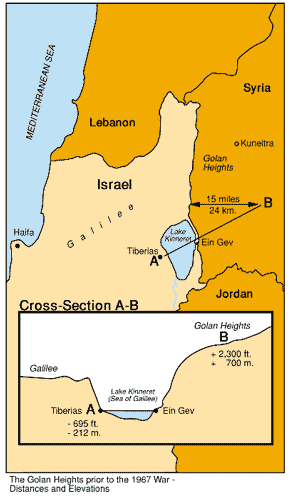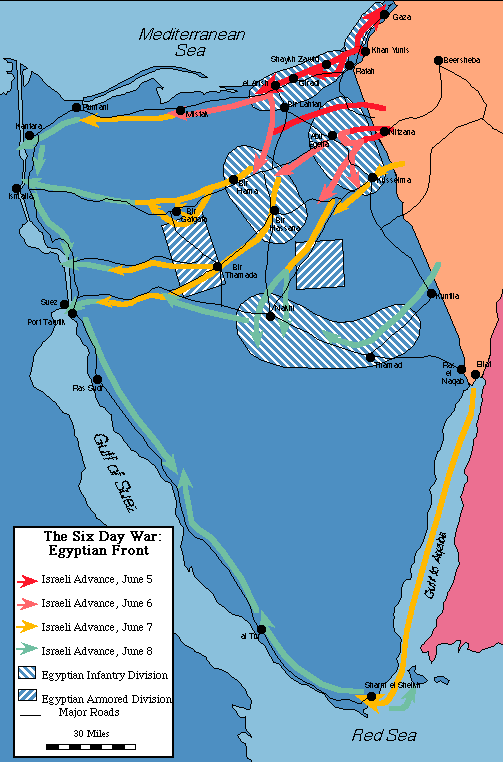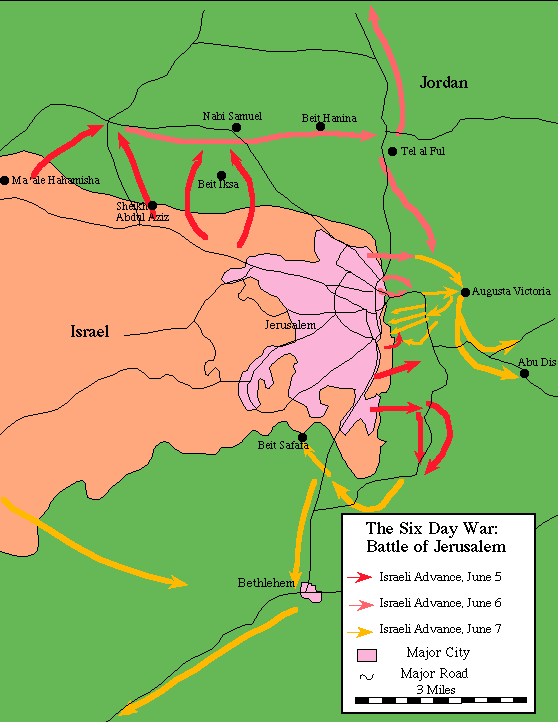The Six-Day War: Background & Overview
(June 5 - 10, 1967)
The Palestinian Liberation Organization
Arab War Plans Revealed
Terror from the Heights
Countdown to War
The Blockade
Escalation
The U.S. Position
Israel Launches Preemptive Strike
The Unity Government
Jerusalem Is Attacked
A Second Exodus
The Stunning Victory
The Nuclear Option
The West Bank and Gaza
Why Didn’t the War Lead to Peace?
Israel consistently expressed a desire to negotiate with its neighbors. In an address to the UN General Assembly on October 10, 1960, Foreign Minister Golda Meir challenged Arab leaders to meet with Prime Minister David Ben-Gurion to negotiate a peace settlement. Egyptian President Gamal Abdel Nasser answered on October 15, saying that Israel was trying to deceive world opinion and reiterating that his country would never recognize the Jewish State. (1)
The Arabs were equally adamant in their refusal to negotiate a separate settlement for the refugees. As Nasser told the United Arab Republic National Assembly on March 26, 1964:
Israel and the imperialism around us, which confront us, are two separate things. There have been attempts to separate them, in order to break up the problems and present them in an imaginary light as if the problem of Israel is the problem of the refugees, by the solution of which the problem of Palestine will also be solved and no residue of the problem will remain. The danger of Israel lies in the very existence of Israel as it is in the present and in what she represents. (2)
The Palestinian Liberation Organization
In 1963, the Arab League decided to introduce a new weapon in its war against Israel — the Palestine Liberation Organization (PLO). The PLO formally came into being during a 1964 meeting of the first Palestinian Congress. Shortly thereafter, the group began to splinter into various factions. Ultimately, the largest faction, Fatah, would come to dominate the organization, and its leader, Yasser Arafat, would become the PLO chairman and most visible symbol. All the groups adhered to a set of principles laid out in the Palestine National Charter, which called for Israel’s destruction.
The PLO’s belligerent rhetoric was matched by deeds. Terrorist attacks by the group grew more frequent. In 1965, 35 raids were conducted against Israel. In 1966, the number increased to 41. In just the first four months of 1967, 37 attacks were launched. The targets were always civilians. (3)
Most of the attacks involved Palestinian guerillas infiltrating Israel from Jordan, the Gaza Strip, and Lebanon. The orders and logistical support for the attacks were coming, however, from Cairo and Damascus. Egyptian President Nasser’s main objective was to harass the Israelis, but a secondary one was to undermine King Hussein’s regime in Jordan.
King Hussein viewed the PLO as both a direct and indirect threat to his power. Hussein feared that the PLO might try to depose him with Nasser’s help or that the PLO’s attacks on Israel would provoke retaliatory strikes by Israeli forces that could weaken his authority. By the beginning of 1967, Hussein had closed the PLO’s offices in Jerusalem, arrested many of the group’s members, and withdrew recognition of the organization. Nasser and his friends in the region unleashed a torrent of criticism on Hussein for betraying the Arab cause. Hussein would soon have the chance to redeem himself.
Arab War Plans Revealed
In September 1965, Arab leaders and their military and intelligence chiefs met secretly at the Casablanca Hotel in Morocco to discuss whether they were ready to go to war against Israel and, if so, whether they should create a joint Arab command. The host of the meeting, King Hassan II, did not trust his Arab League guests and initially planned to allow a joint Shin Bet-Mossad unit known as “The Birds” to spy on the conference. A day before the conference was scheduled to begin, however, the king told them to leave out of fear they would be noticed by the Arab guests. Hassan secretly recorded the meeting and gave it to the Israelis, who learned the Arabs were gearing up for war, but were divided and unprepared.
“These recordings, which were truly an extraordinary intelligence achievement, further showed us that, on the one hand, the Arab states were heading toward a conflict that we must prepare for. On the other hand, their rambling about Arab unity and having a united front against Israel didn’t reflect real unanimity among them,” said Major General Shlomo Gazit, who headed the Research Department of Israel’s Military Intelligence Directorate. (3a)
Terror from the Heights
The breakup of the U.A.R. and the resulting political instability only made Syria more hostile toward Israel. Another major cause of the conflict was Syria’s resistance to Israel’s creation of a National Water Carrier to take water from the Jordan River to supply the country. The Syrian army used the Golan Heights, which tower 3,000 feet above the Galilee, to shell Israeli farms and villages. Syria’s attacks grew more frequent in 1965 and 1966, forcing children living on kibbutzim in the Huleh Valley to sleep in bomb shelters. Israel repeatedly protested the Syrian bombardments to the UN Mixed Armistice Commission, which was charged with policing the cease-fire, but the UN did nothing to stop Syria’s aggression — even a mild Security Council resolution expressing “regret” for such incidents was vetoed by the Soviet Union. Meanwhile, Israel was condemned by the United Nations when it retaliated.
While the Syrian military bombardment and terrorist attacks intensified, Nasser’s rhetoric became increasingly bellicose. In 1965, he announced, “We shall not enter Palestine with its soil covered in sand; we shall enter it with its soil saturated in blood.” (4)
Again, a few months later, Nasser expressed the Arabs’ aspiration: “[el] the full restoration of the rights of the Palestinian people. In other words, we aim at the destruction of the state of Israel. The immediate aim: perfection of Arab military might. The national aim: the eradication of Israel.” (5)
Syria’s attacks on Israeli kibbutzim from the Golan Heights finally provoked a retaliatory strike on April 7, 1967. During the attack, Israeli planes shot down six Syrian fighter planes — MiGs supplied by the Soviet Union. Shortly thereafter, the Soviets — who had been providing military and economic assistance to both Syria and Egypt — gave Damascus false information alleging a massive Israeli military buildup in preparation for an attack. Despite Israeli denials, Syria decided to invoke its defense treaty with Egypt and asked Nasser to come to its aid.
Countdown to War
In early May, the Soviet Union gave Egypt false information that Israel had massed troops along the northern border in preparation for an attack on Syria. In response, Egyptian troops began moving into the Sinai and massing near the Israeli border on May 15, Israel’s Independence Day. By May 18, Syrian troops were prepared for battle along the Golan Heights.
Nasser ordered the UN Emergency Force (UNEF), stationed in the Sinai since 1956 as a buffer between Israeli and Egyptian forces after Israel’s withdrawal following the Sinai Campaign, to withdraw on May 18. Without bringing the matter to the attention of the General Assembly (as his predecessor had promised), Secretary-General U Thant complied with the demand. After the withdrawal of the UNEF, the Voice of the Arabs radio station proclaimed on May 18, 1967:
As of today, there no longer exists an international emergency force to protect Israel. We shall exercise patience no more. We shall not complain any more to the UN about Israel. The sole method we shall apply against Israel is total war, which will result in the extermination of Zionist existence. (6)
An enthusiastic echo was heard on May 20 from Syrian Defense Minister Hafez Assad:
Our forces are now entirely ready not only to repulse the aggression, but to initiate the act of liberation itself, and to explode the Zionist presence in the Arab homeland. The Syrian army, with its finger on the trigger, is united....I, as a military man, believe that the time has come to enter into a battle of annihilation. (7)
The Blockade
On May 23 Egypt closed the Straits of Tiran to all Israeli shipping and all ships bound for Eilat. This blockade cut off Israel’s only supply route with Asia and stopped the flow of oil from its main supplier, Iran.
In 1956, the United States gave Israel assurances that it recognized the Jewish State’s right of access to the Straits of Tiran. In 1957, at the UN, 17 maritime powers declared that Israel had a right to transit the Strait. Moreover, the blockade violated the Convention on the Territorial Sea and Contiguous Zone, which was adopted by the UN Conference on the Law of the Sea on April 27, 1958. (8)
President Johnson expressed the belief that the blockade was illegal and unsuccessfully tried to organize an international flotilla to test it. At the same time, he advised the Israelis not to take any military action. After the war, he acknowledged the closure of the Strait of Tiran was the casus belli (June 19, 1967):
If a single act of folly was more responsible for this explosion than any other it was the arbitrary and dangerous announced decision that the Strait of Tiran would be closed. The right of innocent maritime passage must be preserved for all nations. (9)
Escalation
Nasser was aware of the pressure he was exerting to force Israel’s hand and challenged Israel to fight almost daily. The day after the blockade was set up, he said defiantly: "The Jews threaten to make war. I reply: Welcome! We are ready for war." (10)
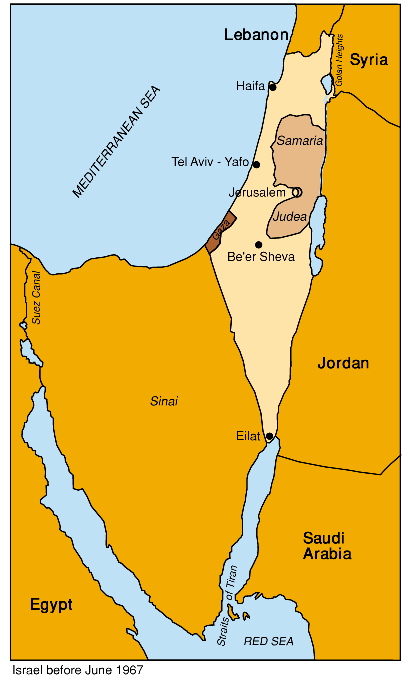 |
Nasser challenged Israel to fight almost daily. "Our basic objective will be the destruction of Israel. The Arab people want to fight," he said on May 27. (11) The following day, he added: We will not accept any...coexistence with Israel...Today the issue is not the establishment of peace between the Arab states and Israel...The war with Israel is in effect since 1948.
( 12)
King Hussein of Jordan signed a defense pact with Egypt on May 30. Nasser then announced:
The armies of Egypt, Jordan, Syria and Lebanon are poised on the borders of Israel...to face the challenge, while standing behind us are the armies of Iraq, Algeria, Kuwait, Sudan and the whole Arab nation. This act will astound the world. Today they will know that the Arabs are arranged for battle, the critical hour has arrived. We have reached the stage of serious action and not declarations. (13)
President Abdur Rahman Aref of Iraq joined in the war of words: "The existence of Israel is an error which must be rectified. This is our opportunity to wipe out the ignominy which has been with us since 1948. Our goal is clear -- to wipe Israel off the map." (14) On June 4, Iraq joined the military alliance with Egypt, Jordan, and Syria.
The Arab rhetoric was matched by the mobilization of Arab forces. Approximately 465,000 troops, more than 2,800 tanks, and 800 aircraft ringed Israel. (15)
By this time, Israeli forces had been on alert for three weeks. The country could not remain fully mobilized indefinitely, nor could it allow its sea lane through the Gulf of Aqaba to be interdicted. Israeli Prime Minister Levi Eshkol had transferred all defense and military decisions to IDF chief of staff Lt. Gen. Yitzhak Rabin, who warned, “I believe we could find ourselves in a situation in which the existence of Israel is at great risk.” On June 2, 1967, Rabin told the Ministerial Committee for Defense, “This forum and myself – and I’m sure this applies to the majority of the army’s officers – don’t want war for its own sake. I think we may find ourselves in a military situation in which we have lost many of our advantages, reaching a position, which I don’t want to express too harshly, in which our existence is in serious danger. The war will be difficult and involve many casualties.” Rabin warned that Israel could not afford to wait to act. “I feel very strongly that the diplomatic-military choke hold around our neck is tightening, and I don’t see anyone else breaking it,” Rabin stated. “Time is not on our side. And in a week or two, or in three or four weeks, the situation will be worse.” (15a)
One man who opposed going to war was David Ben-Gurion. After the bitter experience of the Suez War, when he ordered the attack on Egypt without the support of the United States, and President Eisenhower subsequently forced Israel to withdraw from the territory it won in the war, Ben-Gurion believed Israel needed the support of a Western power. He also feared Israel’s weapons supplies would be jeopardized and Israeli casualties would be enormous. Some Israelis were calling for Ben-Gurion to replace Eshkol, but his anti-war views caused him to lose political support. Instead, pro-war factions of the government who thought Eshkol was too weak to lead the country successfully pressured him to appoint Moshe Dayan as defense minister.
Israel decided to preempt the expected Arab attack. To do this successfully, Israel needed the element of surprise. Had it waited for an Arab invasion, Israel would have been at a potentially catastrophic disadvantage. On June 5, Prime Minister Eshkol gave the order to attack Egypt.
The U.S. Position
The United States tried to prevent the war through negotiations, but it was not able to persuade Nasser or the other Arab states to cease their belligerent statements and actions. Eshkol sent the head of the Mossad, Meir Amit, to Washington to gauge the sentiment for war. Amit learned the flotilla idea had failed and that the United States would not object to an Israeli offensive. (15b) Still, right before the war, Johnson warned: Israel will not be alone unless it decides to go alone.
(16) Then, when the war began, the State Department announced: Our position is neutral in thought, word, and deed.
(17)
Moreover, while the Arabs were falsely accusing the United States of airlifting supplies to Israel, Johnson imposed an arms embargo on the region (France, Israel’s other main arms supplier, also embargoed arms after Israel ignored De Gaulle’s plea not to go to war).
By contrast, the Soviets were supplying massive amounts of arms to the Arabs. Simultaneously, the armies of Kuwait, Algeria, Saudi Arabia and Iraq were contributing troops and arms to the Egyptian, Syrian, and Jordanian fronts. (18)
Israel Launches Preemptive Strike
During the last Israel Defense Forces General Staff meeting before the war, on May 19, 1967, the head of Military Intelligence, Maj. Gen. Aharon Yariv said the Egyptians had radically changed their conduct in the preceding days. “Their moves show a willingness to move towards or even instigate a confrontation with us,” he said. Yariv suggested the Egyptians were afraid Israel was close to building a nuclear weapon. He also said the Soviets may have convinced them of “a wider conspiracy to harm Egypt.” Rabin also addressed the question of Western assistance to respond to the Arab threats. “It’s time we stop deluding ourselves that someone will come to our aid,” said Rabin. “This is the most grave situation since the War of Independence,” he said and told his staff they “should prepare for war.” (18.1)
Thanks to the recordings made by King Hassan II in 1965, along with other sources, “we knew just how unprepared they were for war,” Gazit recalled. “We reached the conclusion that the Egyptian Armored Corps was in pitiful shape and not prepared for battle.” The information in those recordings gave the Israeli army’s leaders confidence “we were going to win a war against Egypt. Prophecies of doom and the feeling of imminent defeat were prevalent among the majority in Israel and the officials outside the defense establishment, but we were confident in our strength.” (18a)
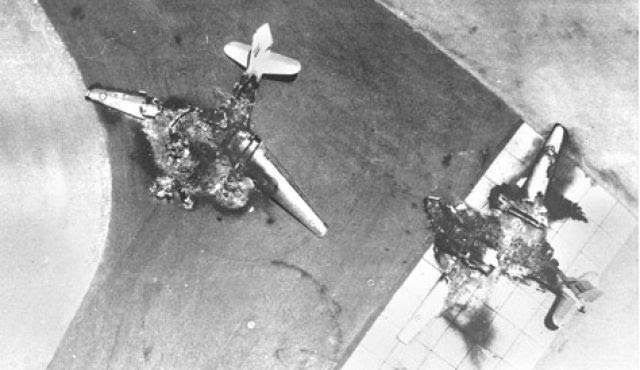 |
| Egyptian planes destroyed in the 1967 war |
Despite this confidence among military leaders, the government made preparations for mass temporary graves for tens of thousands of victims in Tel Aviv parks, a fact journalists were prevented from publishing by the military censor. (18b)
On June 4, 1967, the Israeli cabinet met and voted unanimously to give the defense ministry approval to decide when and how to respond to Egypt’s aggression. Foreign Minister Abba Eban wrote in his memoir:
Once we voted, we knew that we had expressed our people’s will, for amid the alarms and fears of mid-May, our nation gave birth to new impulses within itself. All the conditions which divide us from each other and give our society a deceptive air of fragmentation, all the deeply rooted Jewish recalcitrance toward authority now seemed to have been transmuted into a new metal which few of us had felt before. There had, of course, been some fear, as was natural for a people which had endured unendurable things. Many in the world were afraid that a great massacre was sweeping down upon us. And in many places in Israel there was talk of Auschwitz and Maidenek. The anxiety expressed by friends outside told us that our apprehension was not vain. Yet, as the last days of May were passing into the haze of memory, the people were gripped by a spirit of union and resolve. Men of military age silently laid down their work in factory, office and farm, took up their files of reservist papers and disappeared toward the south. (18c)
Eban also noted that thousands of you men were crowding the offices of Israeli consulates and Jewish Agency institutions throughout the world, asking to be sent to Israel for immediate service.
(18d)
On June 5, 1967, Israel was isolated, but its military commanders had conceived a brilliant war strategy. The entire Israeli Air Force, with the exception of just 12 fighters assigned to defend Israeli air space, took off at 7:14 a.m. in Operation Moked (aka Operation Focus) with the intent of bombing Egyptian airfields while the Egyptian pilots were eating breakfast. The day before the attack, Rabin visited several air bases and told the pilots:
Remember: your mission is one of life or death. If you succeed – we win the war; if you fail – God help us. (18e)
By 11:05 a.m., 180 Egyptian fighter planes were destroyed. Defense Minister Moshe Dayan was not planning to attack Syria until the Syrians attacked Tiberias and Megiddo. Israeli fighters subsequently attacked the Syrian and Jordanian air forces, as well as one airfield in Iraq. By the end of the first day, most of the Egyptian and half the Syrian air forces had been destroyed on the ground. Altogether Israel claimed to have destroyed 302 Egyptian, 20 Jordanian, and 52 Syrian aircraft.(18f)
Despite the success of the opening salvo, Dayan did not want to contradict reports emanating from Cairo, Damascus and Amman that Arab planes had bombed Tel Aviv, Haifa and Jerusalem and caused massive casualties because he wanted the world to continue to view Israel as the victim for as long as possible.
(18g)
The battle then moved to the ground, and some of history’s greatest tank battles were fought between Egyptian and Israeli armor in the blast-furnace conditions of the Sinai desert. On June 9, at 5:45 a.m., the head of Southern Command, Maj. Gen. Yeshayahu Gavish informed the chief of staff: “IDF forces are on the banks of the Suez Canal and the Red Sea. The Sinai Peninsula is in our hands. Congratulations to you and the IDF.”
Meanwhile, the Arab oil-producing countries meeting in Bagdad unanimously decided to stop the flow of oil to any country taking part in an attack on any Arab state.
Click on maps to enlarge
The Unity Government
To demonstrate the national consensus behind the decision to go to war, Prime Minister Eshkol decided on the night the war began to invite opposition leader Menachem Begin to join the government. In the context of Israeli politics, this was an extraordinary move because Begin was not only the opposition leader but someone long seen as dangerous by his rivals. Labor Party leader David Ben-Gurion, just 19 years earlier, had been so afraid of the possibility that Begin’s Irgun was a threat to the newly established state of Israel that he ordered his forces to shell the Altalena arms ship.
Jerusalem Is Attacked
Initially, Israel did not plan to capture the West Bank. “The conquest of the West Bank was made conditional on the situation in the south,” Dayan said the evening of June 5. “In any case, the possibility of capturing the West Bank is considered preferable to breaking a corridor through to Mount Scopus.”
Eshkol sent a message to King Hussein on June 5 saying Israel would not attack Jordan unless he initiated hostilities. When Jordanian radar picked up a cluster of planes flying from Egypt to Israel, and the Egyptians convinced Hussein the planes were theirs, he ordered the takeover of the UN headquarters located near Talpiot and the shelling of West Jerusalem. Snipers were shooting at the King David Hotel and Jordanian mortars had hit the Knesset. It turned out that the planes were Israel’s and were returning from destroying the Egyptian air force on the ground.
Paratrooper Brigade 55, commanded by Colonel Motta Gur, was sent to Jerusalem and given the impossible task of preparing an assault on the city in just 12 hours. Jordan had two battalions of experienced, well-trained fighters assaulting the city. The initial mission was to stop Jordanian shelling of Jewish neighborhoods and rescue a besieged Israeli unit stationed on Mount Scopus, the sole Israeli enclave in East Jerusalem. The soldiers were ordered to stay away from the Old City and its sacred sites.
When the paratroopers arrived, fires were raging and the streets were full of glass. They could smell exploding shells. When they got off their bus, people suddenly began to appear from all directions carrying food. People came from all over,
Avital Geva recalled in the documentary In Our Hands. They didn’t care about the bombings. Women brought food, sweets, coffee, everything. You cannot describe it. It was spontaneous love.
At 2 a.m. on June 6, one of Brigade 55’s three battalions attacked the Jordanian position known as Ammunition Hill, and fought one of the bloodiest battles of the war. The paratroopers blasted their way through the minefields and cut through layers of razor wire fences, but the price was high. In just the initial thrust, seven soldiers were killed and more than a dozen injured. The Israelis had not trained for trench warfare and had to improvise. Two soldiers jumped on tanks and ordered them up the hill firing at every Jordanian soldier they spotted. Years later, a Jordanian soldier admitted the tanks had convinced them the battle was lost and they retreated from the hill. It had taken three hours to capture the Jordanian command bunker. Of the 260 soldiers who fought at Ammunition Hill, only eleven emerged without being wounded or killed — 36 died. The Jordanians lost 71 men. After the battle, the Israelis buried 17 Jordanian soldiers in a mass grave with the English epitaph, Here lay 17 brave Jordanian soldiers, IDF, 1967.
A second battalion, the 66th, was assigned to take up a position at the Rockefeller Museum opposite the Arab quarter of the Old City to prepare to enter the city if given the order. The soldiers were unfamiliar with the city, however, and took a wrong turn that led down a narrow alley where they faced withering fire from the Jordanian forces. The Israelis made their way through to the museum, but only 30 paratroopers, half their original force, emerged unharmed from what they later called the Alley of Death.
Meanwhile, a third group of paratroopers from the 71st battalion succeeded in achieving its objective of securing a position on Mount Scopus.
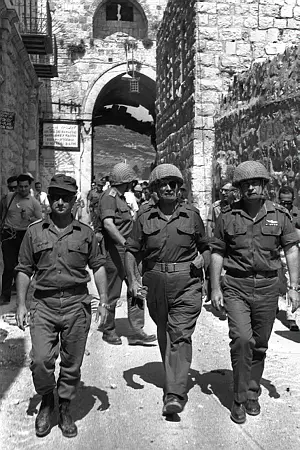 |
While forbidding the army from entering the Old City, Eshkol said, “if the connection to Mount Scopus is completed this morning, the West Bank should be conquered up to the peak mountain ridges, while enabling escape routes for civilians.” Palestinians took advantage of those routes to flee eastward.
The night after the battle on Ammunition Hill, Dayan and Uzi Narkiss, the commander responsible for combating the Jordanian offensive, met on Mount Scopus and discussed how they might take the Old City. Narkiss explained where his troops were deployed and the various gates through which they could enter the city. Dayan asked, Why don’t you go through the Lion’s Gate?
Narkiss had not considered this option and said to Dayan, You know what Moshe, since the time of King David, Jerusalem has never been conquered from the east.
Dayan replied, Then this will be the second and last time.
(18h)
Nasser and Hussein still hoped to save face and their remaining troops. During a phone conversation, they decided to tell the world they were losing because the British and Americans were helping the Israelis. The Israelis had recorded the call, however, and shared it with the world, which confirmed the denials of Western officials. President Johnson referred to the episode as The Big Lie.
The Israelis offered Hussein a way out of the dilemma. Eshkol said Israeli troops were prepared to take the Old City but would not do it if the king agreed to an immediate unconditional ceasefire, expelled the Egyptian generals from Jordan, and began a peace process with Israel. Hussein’s response was to send troops back to Jerusalem in hopes of holding as much territory as possible before a ceasefire was declared.
Dayan realized he had to make a decision. At 6:15 a.m. on June 7, Dayan ordered the encirclement of the Old City and instructed the army to enter with the warning not to damage any of the holy places. Fortunately, the night before, most of the Jordanian troops had retreated, so when the paratroopers stormed the gate onto the Via Dolorosa, they met no resistance. Gur led the charge up to the Temple Mount and radioed headquarters at 10:08 a.m., “The Temple Mount is in our hands and our forces are by the [Western] Wall.” The brigade’s chief communications officer, Ezra Orni, hung an Israeli flag over the Dome of the Rock. Dayan was observing from Mount Scopus and angrily radioed Gur, Do you want to set the Middle East on fire?
The flag was removed. Shortly afterward, Dayan arrived with Rabin to formally mark the Jews’ return to their historic capital and their holiest site. At the Western Wall, the IDF’s chaplain, Rabbi Shlomo Goren, blew a shofar to celebrate the event, which was broadcast live on Voice of Israel Radio.
The joy of reuniting Jerusalem was tempered by the loss of so many soldiers. A total of 430 paratroopers were wounded and 97 were killed.
Hussein’s decision changed the course of the war and history. Following the shelling of Jerusalem, Israel counterattacked and took over the West Bank of Jordan within 48 hours. According to Major General Rephael Vardi, the Palestinians believed the Jordanian and other Arab forces were going to occupy Israel quickly. Such was their surprise that the Israeli forces that entered Nablus were welcomed by the population with flowers and with flags because they believed that these were Iraqi forces that had come to support the Jordanians.
(18i)
A Second Exodus
After Jordan launched its attack on June 5, approximately 325,000 Palestinians living in the West Bank fled to other parts of Jordan, primarily to avoid being caught in the cross-fire of a war. (19)
A Palestinian refugee who was an administrator in a UNRWA camp in Jericho said Arab politicians had spread rumors in the camp. "They said all the young people would be killed. People heard on the radio that this is not the end, only the beginning, so they think maybe it will be a long war and they want to be in Jordan." (20)
Some Palestinians who left preferred to live in an Arab state rather than under Israeli military rule. Members of various PLO factions fled to avoid capture by the Israelis. Nils-Göran Gussing, the person appointed by the UN Secretary-General to investigate the situation, found that many Arabs also feared they would no longer be able to receive money from family members working abroad. (21)
Rabin issued the following order, Prevent people from leaving for Jordan, but not by force. We’re trying not to increase the population of Jerusalem. Only 200 families who were living in synagogues and desecrating them were expelled. We found them alternative housing. There are no expulsions. I don’t know what the diplomatic solutions will be. That isn’t the army’s responsibility.
(21a)
Israeli forces ordered a handful of Palestinians to move for "strategic and security reasons." In some cases, they were allowed to return in a few days, in others; Israel offered to help them resettle elsewhere. (22) The net result was that a new refugee population had been created, and the old refugee problem was made worse.
The Stunning Victory
While most IDF units were fighting the Egyptians and Jordanians, a small, heroic group of soldiers were left to defend the northern border against the Syrians. It was not until the Jordanians and Egyptians were subdued that reinforcements could be sent to the Golan Heights, where Syrian gunners commanding the strategic high ground made it exceedingly difficult and costly for Israeli forces to penetrate. Finally, on June 9, after two days of heavy air bombardment, Israeli forces succeeded in breaking through the Syrian lines.
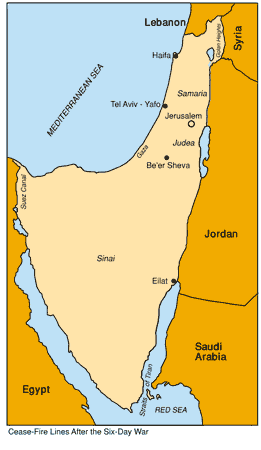 |
After just six days of fighting, Israeli forces were in a position to march on Cairo, Damascus, and Amman. By this time, the principal objectives of capturing the Sinai and the Golan Heights had been accomplished, and Israeli political leaders had no desire to fight in the Arab capitals. Furthermore, the Soviet Union had become increasingly alarmed by the Israeli advances and was threatening to intervene. At this point, U.S. Secretary of State Dean Rusk advised the Israelis “in the strongest possible terms” to accept a cease-fire. On June 10, Israel did just that.
The victory came at a very high cost. In storming the Golan Heights, Israel suffered 115 dead-roughly the number of Americans killed during Operation Desert Storm. Altogether, Israel lost twice as many men — 777 dead and 2,586 wounded-in proportion to her total population as the U.S. lost in eight years of fighting in Vietnam. (23) Also, despite the incredible success of the air campaign, the Israeli Air Force lost 46 of its 200 fighters. (24) The death toll on the Arab side was 15,000 Egyptians, 2,500 Syrians, and 800 Jordanians.
By the end of the war, Israel had conquered enough territory to more than triple the size of the area it controlled, from 8,000 to 26,000 square miles. The victory enabled Israel to unify Jerusalem. Israeli forces had also captured the Sinai, Golan Heights, Gaza Strip and West Bank.
The Nuclear Option
A previously little-known story was publicized just before the 50th anniversary of the war, disclosing that Israel had considered using a nuclear weapon to scare
the Egyptians. According to retired brigadier general Itzhak Yaakov, Israel had a contingency plan code-named Shimshon or Samson. [Israel’s use of nuclear weapons as a last resort, if it faced annihilation, is sometimes referred to as the Samson Option.] Yaakov said Israel rushed to assemble an atom bomb with the intention of detonating it on a mountaintop in the Sinai desert about 12 miles from an Egyptian military complex at Abu Ageila as a warning to Egypt and the other Arab states if Israel feared it would lose the war.
During a meeting of the Knesset Foreign Affairs and Defense Committee on May 26, 1967, Eshkol reported: “Today four [Egyptian] airplanes flew over Israel. We immediately telegrammed Abba Eban about it. The purpose of a certain weapon can be crucial in this matter, and I don’t mean something which is out of this world. It’s a weapon that exists in [other countries] in the hundreds and thousands.”
As the New York Times reported, The plan, if activated by order of the prime minister and military chief of staff, was to send a small paratrooper force to divert the Egyptian Army in the desert area so that a team could lay preparations for the atomic blast. Two large helicopters were to land, deliver the nuclear device and then create a command post in a mountain creek or canyon. If the order came to detonate, the blinding flash and mushroom cloud would have been seen throughout the Sinai and Negev Deserts, and perhaps as far away as Cairo.
“Look, it was so natural,” said Mr. Yaakov, according to a transcription of a taped interview. “You’ve got an enemy, and he says he’s going to throw you to the sea. You believe him.”
“How can you stop him?” he asked. “You scare him. If you’ve got something you can scare him with, you scare him.” (24a)
The West Bank and Gaza
Israel now ruled more than three-quarters of a million Palestinians — most of whom were hostile to the government. Nevertheless, Israel allowed many of the refugees who fled the fighting to return, reuniting more than 9,000 Palestinian families in 1967. Ultimately, more than 60,000 Palestinians were allowed to return. (25)
In November 1967, the United Nations Security Council adopted Resolution 242, which established a formula for Arab-Israeli peace whereby Israel would withdraw from territories occupied in the war in exchange for peace with its neighbors. This resolution has served as the basis for peace negotiations from that time on.
Israel’s leaders fully expected to negotiate a peace agreement with their neighbors that would involve some territorial compromise. According to Medzini, On June 19, the government adopted a secret resolution instructing Eban to tell the Americans that Israel was prepared to withdraw from the Golan and Sinai for full peace with Syria and Egypt and a willingness to create special arrangements with Jordan.
(26)
Consequently, instead of annexing the West Bank, a military administration was created. According to Major General Vardi, Israel did not expect to be saddled with responsibility for the captured territories:
We did not believe that the Israeli rule of the territories would last more than a few months following our experience after the Sinai Campaign in 1956 in which by March 1957 we were compelled to withdraw from the whole of Sinai. Some preparations for a military government in the West Bank, in case of war, had been made, but these were minimal because the possibility that the Big Powers would allow the occupation of the West Bank seemed unreal. Therefore we had to start organizing the military government virtually from scratch in order to establish the rule of the IDF, assume the functions of a civil government, maintain law and order, organize and provide public services, look after all the other necessities of the population, restore life to normal, and especially to reconstruct the economy. (27)
No occupation is pleasant for the inhabitants, but the Israeli authorities did try to minimize the impact on the population. Don Peretz, a frequent writer on the situation of Arabs in Israel and a sharp critic of the Israeli government, visited the West Bank shortly after the Israeli troops had taken over. He found they were trying to restore normal life and prevent any incidents that might encourage the Arabs to leave their homes. (28)
Except for the requirement that school texts in the territories be purged of anti-Israel and anti-Semitic language, the authorities tried not to interfere with the inhabitants. They did provide economic assistance; for example, Palestinians in the Gaza Strip were moved from camps to new homes. This stimulated protests from Egypt, which had done nothing for the refugees when it controlled the area.
Arabs were given freedom of movement. They were allowed to travel to and from Jordan. In 1972, elections were held in the West Bank. Women and non-landowners, unable to participate under Jordanian rule, were now permitted to vote.
East Jerusalem Arabs were given the option of retaining Jordanian citizenship or acquiring Israeli citizenship. They were recognized as residents of united Jerusalem and given the right to vote and run for the city council. Also, Islamic holy places were put in the care of a Muslim Council. Despite the Temple Mount’s significance in Jewish history, Jews were barred from conducting prayers there.
Why Didn’t the War Lead to Peace?
Israelis thought that routing the Arab armies would convince their leaders they had no hope of destroying Israel and would agree to a peace agreement. On June 19, 1967, the Israeli Cabinet secretly decided to exchange Sinai and the Golan for peace agreements with Egypt and Syria; but no consensus was reached on the West Bank, though the Cabinet agreed to incorporate Gaza into Israel and to resettle refugees elsewhere in the region.
(29)
The Arabs, however, had been humiliated and would have to regain their honor before contemplating any accommodation with Israel. Instead of peace, the Arab League Summit in Khartoum in August 1967 declared the Arab position toward Israel would be no peace, no negotiations, and no recognition.
On November 22, 1967, the UN Security Council unanimously adopted Resolution 242, calling on Israel to withdraw from territory – not all the territories – captured in the war in exchange for “secure and recognized boundaries” with the aim of achieving a “peaceful and accepted settlement.” This resolution became the basis for future peace talks.
Almost immediately after the end of the war, any hope for peace was shattered when Egypt began shelling Israeli positions near the Suez Canal. Nasser believed Israel could not withstand a lengthy war of attrition. Before a cease-fire was declared three years later, 1,424 Israeli soldiers and more than one hundred civilians were killed; Egypt suffered approximately five thousand dead.
Sources: Mitchell G. Bard, The Complete Idiot’s Guide to Middle East Conflict. 4th Edition. NY: Alpha Books, 2008;
Content supplied by CBN ©2016 The Christian Broadcasting Network, Inc., All Rights Reserved.
(1)Encyclopedia Americana Annual 1961, (NY: Americana Corporation, 1961), p. 387.
(2)Yehoshafat Harkabi, Arab Attitudes To Israel, (Jerusalem: Keter Publishing House, 1972), p. 27.
(3)Howard Sachar, A History of Israel: From the Rise of Zionism to Our Time, (NY: Alfred A. Knopf, 1979), p. 616.
(3a)Sue Surkes, “Morocco tipped off Israeli intelligence, ‘helped Israel win Six Day War,’” Times of Israel, (October 16, 2016).
(4)Samuel Katz, Battleground-Fact and Fantasy in Palestine, (NY: Bantam Books, 1985), pp. 10-11, 185.
(5)Netanel Lorch, One Long War, (Jerusalem: Keter, 1976), p. 110.
(6) Isi Leibler, The Case For Israel, (Australia: The Globe Press, 1972), p. 60.
(7)Ibid.
(8)United Nations Conference on the Law of the Sea, (Geneva: UN Publications 1958), pp. 132-134.
(9)Yehuda Lukacs, Documents on the Israeli-Palestinian Conflict 1967-1983, (NY: Cambridge University Press, 1984), pp. 17-18; Abba Eban, Abba Eban, (NY: Random House, 1977), p. 358
(10)Eban, p. 330.
(11)Leibler, p. 60.
(12)Leibler, p. 18.
(13)Leibler, p. 60.
(14)Leibler, p. 18.
(15)Chaim Herzog, The Arab-Israeli Wars, (NY: Random House, 1982), p. 149.
(15a)Gili Cohen, Six-Day War documents show Dayan proposed Arab rule in parts of West Bank,
Haaretz,(June 4, 2015).
(15b)Michael Bar-Zohar, The War Nobody Wanted,
inFocus, (Spring 2017), p. 12.
(16)Lyndon B. Johnson, The Vantage Point: Perspectives of the Presidency 1963-1969, (NY: Holt, Rinehart and Winston, 1971), p. 293.
(17)AP, (June 5, 1967).
(18)Sachar, p. 629.
(18.1)Gili Cohen, “Minutes of Last General Staff Meeting Before 1967 War: ‘Egypt Worried Israel Close to Nuclear Bomb,’” Haaretz, (June 24, 2017).
(18a)Sue Surkes, “Morocco tipped off Israeli intelligence, ‘helped Israel win Six Day War,’” Times of Israel, (October 16, 2016).
(18b)Meron Medzini, 1967 | The international media and the Six-Day War,
Fathom, (2017).
(18c)Abba Eban, An Autobiography, (NY: Random House, 1977), pp. 400-401.
(18d)Eban, p. 401.
(18e)Michael Bar-Zohar, The War Nobody Wanted,
inFocus, (Spring 2017), p. 12.
(18f)The six-day war: Israel claims land and air successes as Britain and US declare neutrality,
The Guardian, (June 6, 1947).
(18g)Meron Medzini, 1967 | The international media and the Six-Day War,
Fathom, (2017).
(18h)Jerusalem Report, (June 12, 2017).
(18i)Major General Rephael Vardi, The Beginning of Israeli Rule in Judea and Samaria,
Jerusalem Center for Public Affairs, (April 16, 1989).
(19)Encyclopedia American Annual 1968, p. 366.
(20)George Gruen, "The Refugees of Arab-Israeli Conflict," (NY: American Jewish Committee, March 1969), p. 5.
(21)Gruen, p. 5.
(21a)Gili Cohen, “Minutes of Last General Staff Meeting Before 1967 War: ‘Egypt Worried Israel Close to Nuclear Bomb,’” Haaretz, (June 24, 2017).
(22)Gruen, p. 4.
(23)Katz, p. 3.
(24)Jerusalem Post, (4/23/99).
(24a)William J. Broad and David E. Sanger, “‘Last Secret’ of 1967 War: Israel’s Doomsday Plan for Nuclear Display,” New York Times, (June 3, 2017).
(25)Encyclopedia American Annual 1968, p. 366.
(26)Meron Medzini, 1967 | The international media and the Six-Day War,
Fathom, (2017).
(27)Major General Rephael Vardi, The Beginning of Israeli Rule in Judea and Samaria,
Jerusalem Center for Public Affairs, (April 16, 1989).
(28)Don Peretz, "Israel’s New Dilemma," Middle East Journal, (Winter 1968), pp. 45-46.
(29)Aaron David Miller, “The Myths About 1967 That Just Won’t Die,” The Atlantic, (June 2, 2017).
Photo of Dayan, Rabin and Narkiss, Ilan Bruner, Israeli Government National Photo Collection
